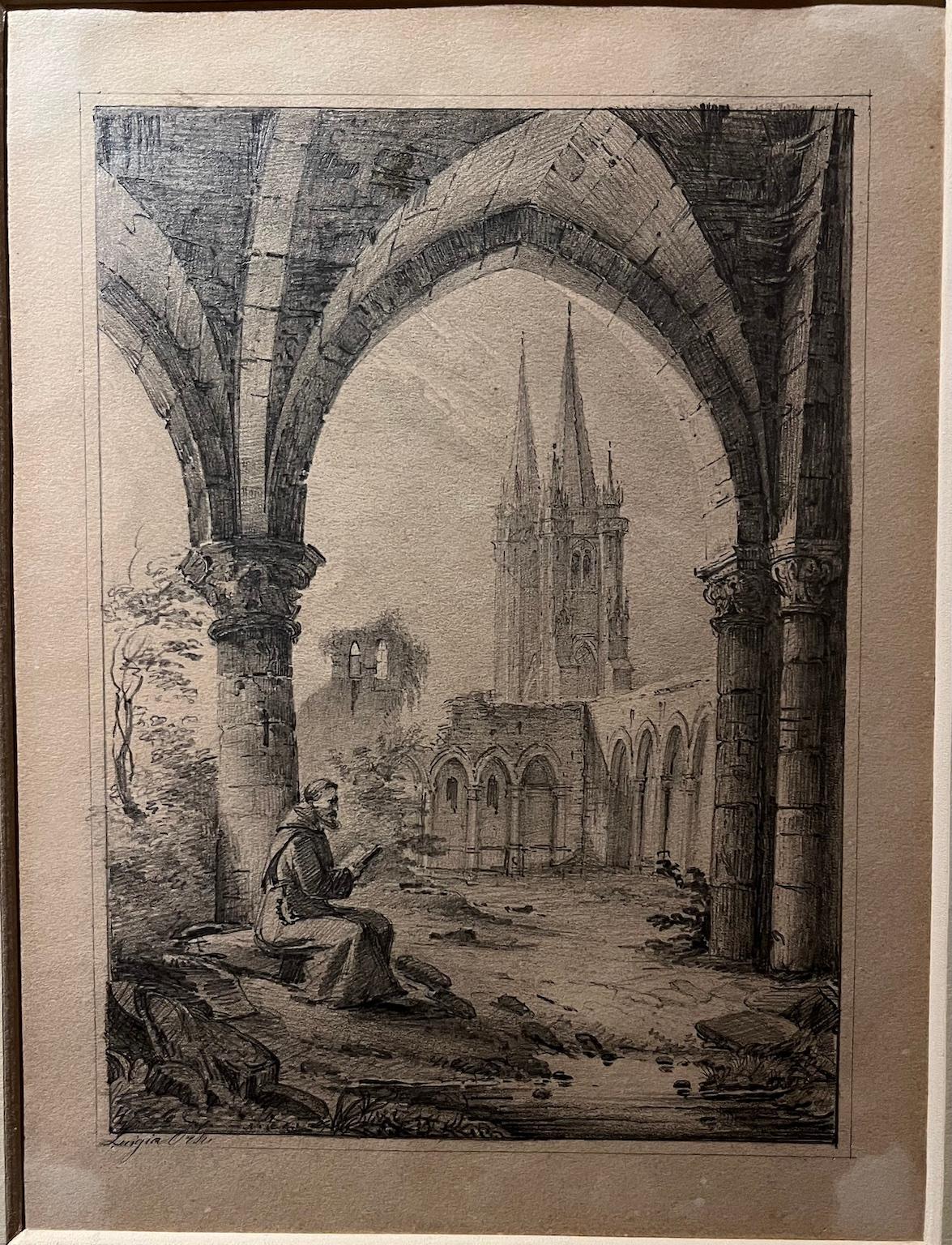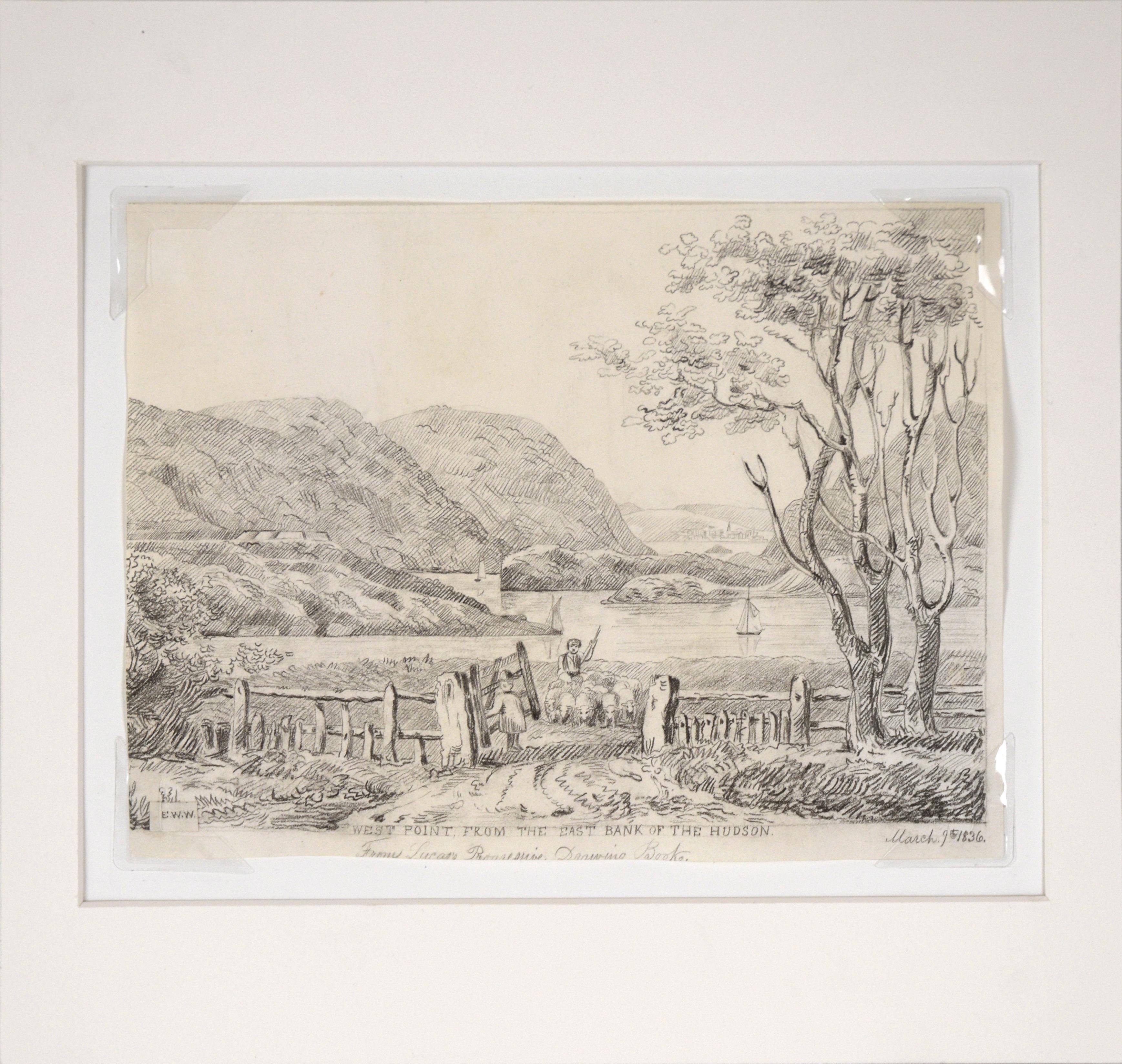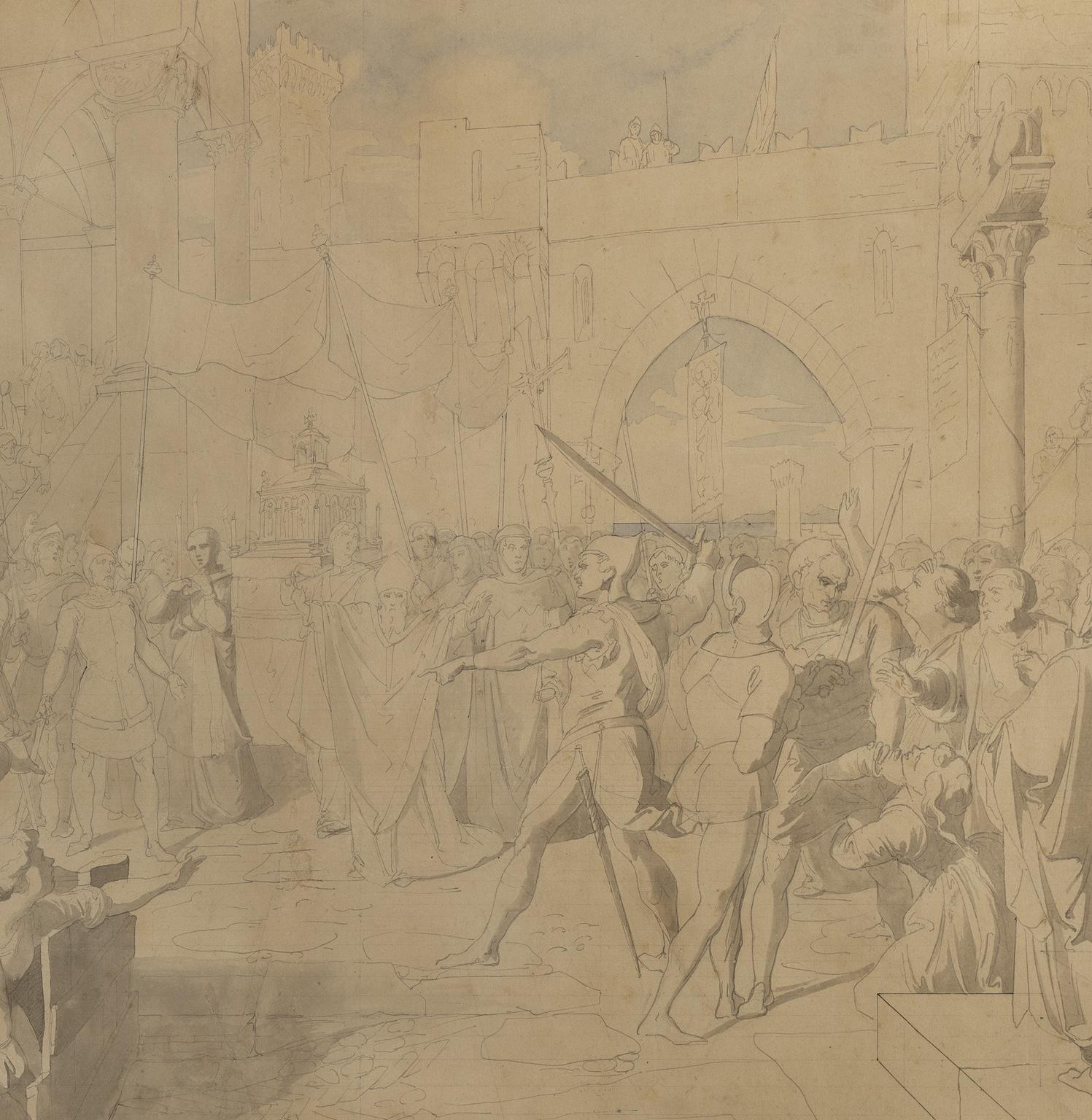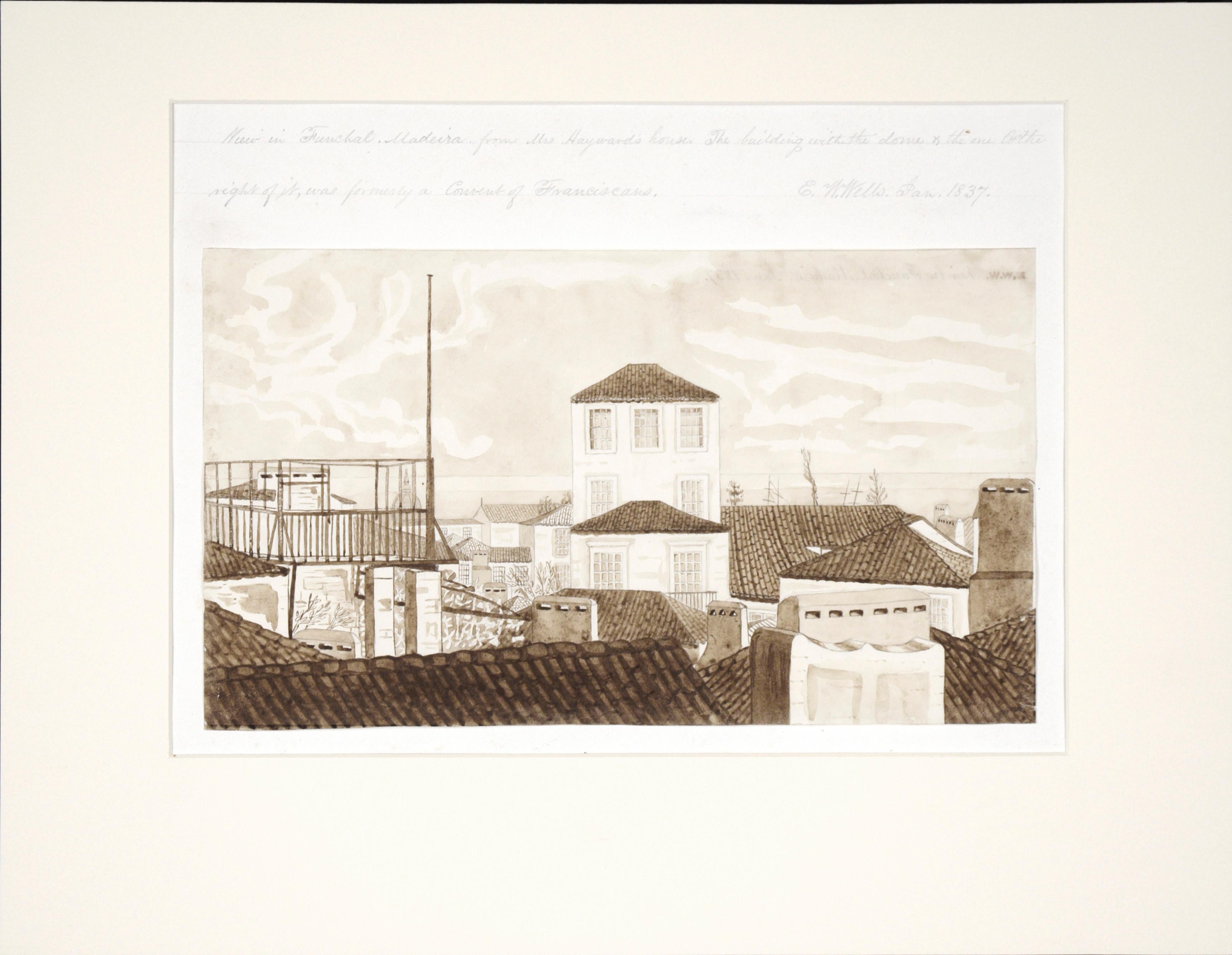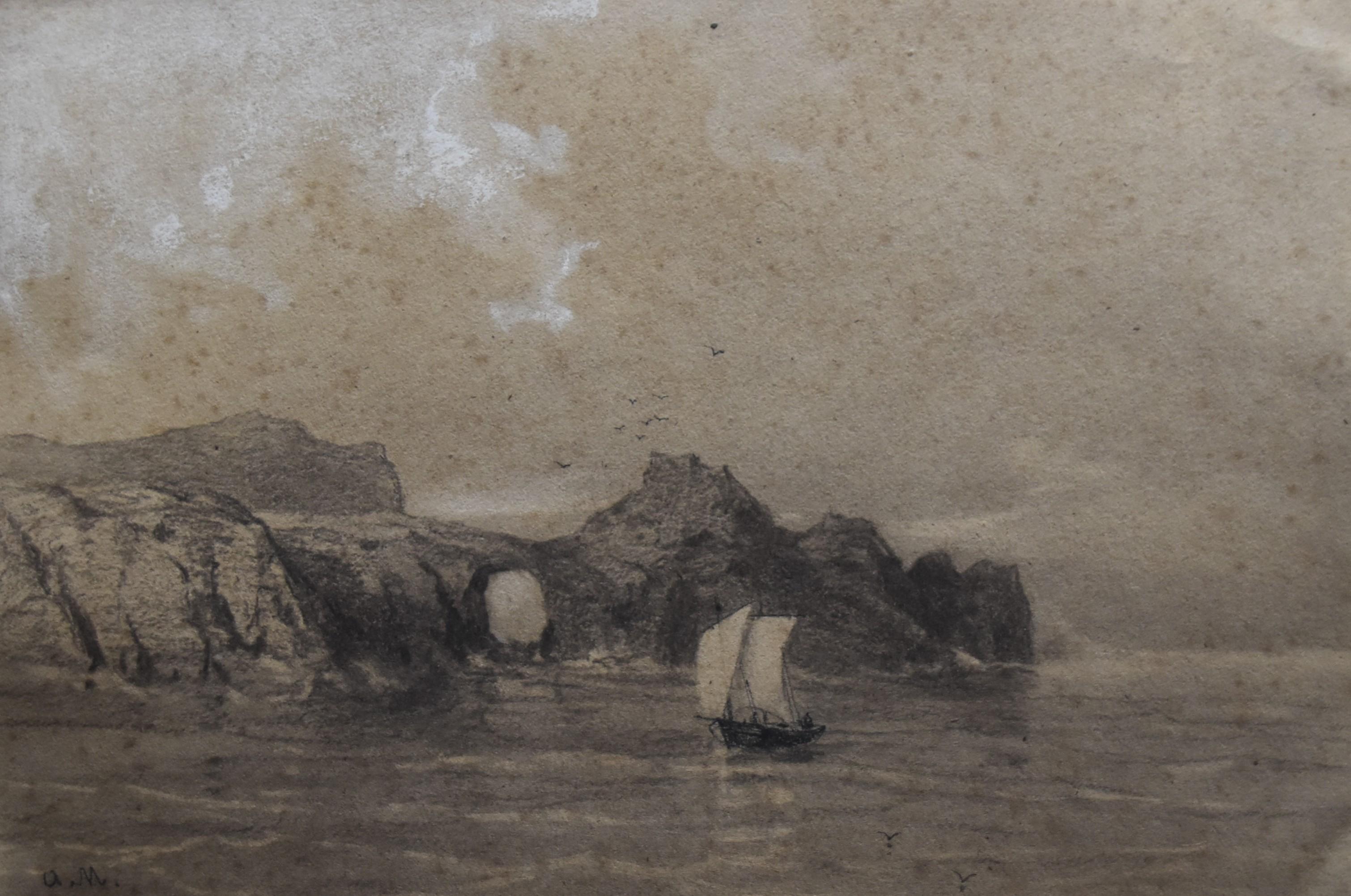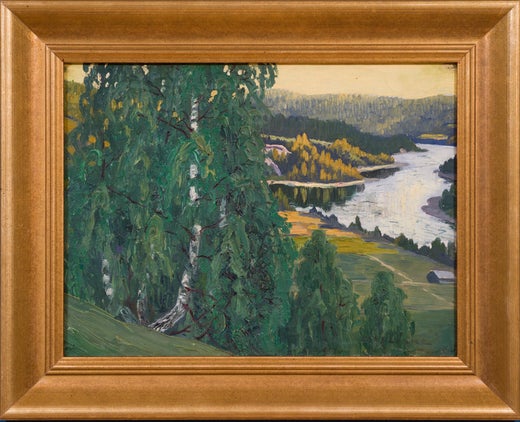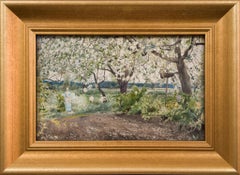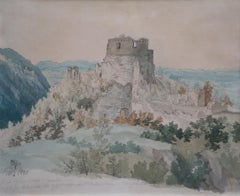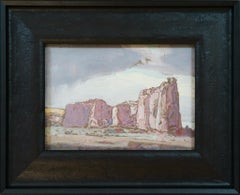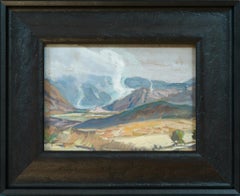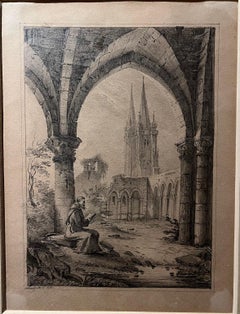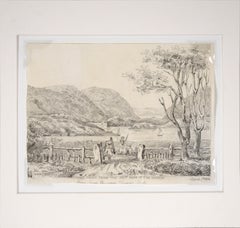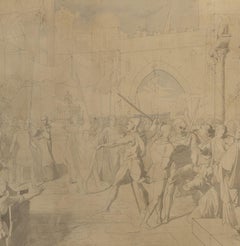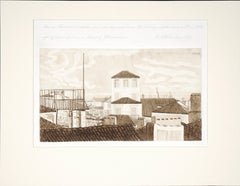Articles similaires à Evening Calm by the Northern River
Vous voulez plus d'images ou de vidéos ?
Demander au vendeur plus d'images ou de vidéos
1 sur 9
Oscar LyckeEvening Calm by the Northern Riverc. 1910
c. 1910
À propos de cet article
ink on paper
signed OSC. LYCKE
unframed 24 x 34 cm (9.4 x 13.4 in)
framed 33.5 x 43.5 cm (13.2 x 17.1 in)
Provenance:
Acquired directly from Katarina Gunnarsson, who inherited the painting from her mother, Barbro, the daughter of the artist.
Essay:
This ink landscape by Oscar Lycke (c. 1910) evokes the tranquil beauty of a remote northern valley. Bold black lines sweep across the paper to define a still river winding between gently rolling hills. In the foreground a humble log cabin nestles at the water’s edge, framed by slender birch and fir trees. Above, the sky is hinted at with strokes and washes of ink, suggesting a soft, diffused light. Although rendered simply, the scene feels remarkably three‑dimensional: darkly inked foreground shapes push forward against lighter, more delicate strokes in the distance. The effect is one of quiet serenity – the kind of calm encounter with nature that Lycke loved to capture. Lycke often painted and drew the Indalsälven valley in northern Sweden, especially around the village of Liden, and this image likely reflects that region. The gently undulating ridges and the placid river here closely resemble the Liden landscape he returned to again and again. One can almost imagine the shadowy woods and glassy water of Bodacke in Liden at dusk. This setting – an unspoiled Nordic river valley – was a recurring motif in Lycke’s work. He was deeply attached to the Swedish north; his art consistently celebrates its expansive forests, mirrored lakes, and rustic farmsteads.
Technique and Style
Lycke’s mastery of ink is evident in every expressive stroke. Using only black ink on paper, he achieves a rich range of tone and texture. Thick, confident strokes suggest the solidity of the cabin walls and tree trunks, while thinner, more rapid lines imply the finer details of foliage and rippling water. Some areas are left nearly blank – washes of pale ink indicate sky and distant hills – creating bright highlights that contrast with the deep blacks. The result is a dynamic interplay of light and shadow. Lycke applies the ink with a kind of lyrical energy: lines sometimes curl and dance, giving life to the scene, yet everywhere they remain under control, defining form with precision. This balance of spontaneity and discipline reflects his self-taught background. Without formal academic training, Lycke developed a personal technique that feels at once free and deliberate. The drawing’s expressive lines and compositional skill speak to his innate draftsmanship. Even in monochrome, he captures the “Nordic light” – the cool glow of a long summer evening – using subtle gradations of gray and sharp silhouettes against the sky. The overall effect is both bold and atmospheric, demonstrating Lycke’s confidence in handling ink as his medium.
Education and International Success
Lycke’s artistic journey was unconventional. Born in Sundsvall in 1877, he never attended a formal art academy. A childhood gift for drawing grew into a lifelong passion, and as a young man he moved to Stockholm to try making art his livelihood. He spent those early years studying nature directly and producing illustrations for magazines – a practical way to hone his skill. Around the turn of the century he even traveled to North America on art-study trips, broadening his perspective far from Sweden. Despite humble beginnings (and one discouraging schoolmaster), Lycke persevered. Over time he exhibited widely across Sweden – from Gothenburg to the north – and gradually gained recognition. His most remarkable success came abroad. In the 1910s Lycke brought his northern landscapes to New York, and American audiences were captivated. Contemporary accounts report that his exhibition in New York was a sensation: every painting he showed there sold quickly. The clear, romantic portrayal of Swedish wilderness and the masterful technique behind each canvas and drawing resonated with collectors and critics. In this way, Lycke achieved international acclaim, even while remaining relatively humble at home. By the time of his later shows – in Stockholm and back in Sundsvall – he was celebrated as a leading interpreter of Sweden’s natural beauty. Throughout his career, Lycke’s work remained rooted in the Swedish countryside. He captured all seasons of the north – from snowy winter nights to the midnight sun of summer – but always with the same reverence for nature. In Evening Calm by the Northern River, we see that devotion distilled into a simple ink study.
- Créateur:Oscar Lycke (1877 - 1927, Suédois)
- Année de création:c. 1910
- Dimensions:Hauteur : 24 cm (9,45 po)Largeur : 34 cm (13,39 po)
- Support:
- Mouvement et style:
- Période:
- État:Very good condition. age related patina. A new black frame with UV protected art glass is included.
- Adresse de la galerie:Stockholm, SE
- Numéro de référence:1stDibs : LU1445216379802
Oscar Lycke était un peintre suédois surtout connu pour ses représentations évocatrices des paysages nordiques. Né à Sundsvall en 1877, il a consacré sa vie à capturer les forêts, les rivières et la lumière du Norrland dans des œuvres qui allient le romantisme national à un sens aigu du réalisme. Ses peintures sont toujours appréciées aujourd'hui pour leur atmosphère vivante et leur lien sincère avec l'environnement nordique. Largement autodidacte, Lycke a fait preuve de talent artistique dès son plus jeune âge. Après avoir reçu des encouragements mitigés de la part de ses maîtres d'école, il quitte Sundsvall à l'âge de 20 ans pour poursuivre une carrière d'artiste à Stockholm. Les premières années ont été difficiles - il n'avait pas de formation officielle et avait du mal à gagner sa vie - mais son dévouement n'a jamais faibli. Au fil du temps, il s'est fait connaître et a commencé à exposer dans plusieurs villes de Suède, dont Malmö et Norrköping, ainsi qu'à Copenhague et à New York. Lycke était constamment en mouvement, voyageant à travers la Suède à la recherche de nouveaux paysages et d'inspiration. Il a vécu à différents moments dans des endroits comme Delsbo et Hudiksvall, et pendant les années de guerre de 1915-1918, il s'est installé à Stockholm, passant les étés avec sa famille à Räfsnäs, dans l'archipel de Stockholm. Il finit par retourner à Sundsvall, sa ville natale, où il continue à peindre jusqu'à la fin de sa vie. Son style artistique reflète l'ambiance culturelle de l'art suédois du début du XXe siècle. Comme beaucoup de ses contemporains, Lycke était attiré par les thèmes nationaux, trouvant la beauté et l'identité dans la campagne suédoise. Ses paysages représentent souvent la lumière changeante de l'aube ou du crépuscule, des forêts d'épicéas denses et des chemins tranquilles aux couleurs naturelles. La résonance émotionnelle de son travail, enraciné à la fois dans la mémoire et le lieu, a fait de lui un favori, en particulier parmi ceux qui ont des liens avec le Nord. Oscar AGE est décédé en 1927 à l'âge de 50 ans, après une longue période de maladie et de baisse de la vue. Une exposition commémorative au musée de Sundsvalls à la fin des années 1970 a réaffirmé son importance, notamment en tant que peintre du nord de la Suède. Aujourd'hui, Oscar Timeless-art reste une figure emblématique de l'art suédois du début du XXe siècle. On se souvient de ses représentations lyriques des paysages du Norrland et de sa capacité à transformer la nature de tous les jours en quelque chose d'intemporel.
À propos du vendeur
5,0
Vendeur Platine
Vendeurs premium dont la note est supérieure à 4,7 et le délai de réponse de 24 heures maximum
Établi en 2020
Vendeur 1stDibs depuis 2020
179 ventes sur 1stDibs
Temps de réponse habituel : <1 heure
Associations
International Confederation of Art and Antique Dealers' Associations
- ExpéditionRecherche du devis...Expédition depuis : Stockholm, Suède
- Politique des retours
Certaines parties de cette page ont été traduites automatiquement. 1stDibs ne garantit pas l'exactitude des traductions. L'anglais est la langue par défaut de ce site web.
Garantie d'authenticité
Bien qu'il soit peu probable que la situation se présente, dans le cas où vous rencontreriez un problème d'authenticité d'un article, contactez-nous dans un délai d'un an pour obtenir un remboursement intégral. DétailsGarantie de remboursement
Si votre article n'est pas conforme à la description, est endommagé pendant le transport ou ne vous est pas livré, contactez-nous sous 7 jours pour obtenir un remboursement intégral. DétailsAnnulation sous 24 heures
Vous disposez d'un délai de 24 heures pour annuler votre achat sans motif.Des vendeurs professionnels agréés
Nos vendeurs de renommée mondiale doivent respecter des normes strictes en matière de service et de qualité, afin de préserver l'intégrité de nos fiches produit.Garantie d'alignement des prix
Si vous constatez qu'un autre vendeur a mis en vente le même article à un prix inférieur sur un autre site, nous nous alignerons sur ce prix.Livraison en toute confiance à l'international
Notre réseau de transporteurs de premier ordre propose des options d'expédition spécialisées dans le monde entier, y compris des livraisons personnalisées.Plus d'articles de ce vendeur
Tout afficherAquarelle The Garden at Sickelsjö, 1883
Nous avons le plaisir de présenter une superbe aquarelle de l'artiste suédois Albert Theodor Gellerstedt. Cette œuvre d'art, intitulée "Sickelsjö Trädgård", a été créée le 8 juin 188...
Catégorie
années 1880, Romantique, Dessins et aquarelles - Paysage
Matériaux
Papier, Aquarelle
Les ruines du château impérial à l'extérieur de Split en Croatie
Gustaf Wilhelm Palm (1810-1890) Suède
Les ruines du château impérial à l'extérieur de Split en Croatie
crayon et aquarelle
sans cadre : 23,6 x 29,2 cm (9 1/4 x 11 1/2 in)
encadré ...
Catégorie
années 1840, Romantique, Dessins et aquarelles - Paysage
Matériaux
Papier, Aquarelle
Inscription Rock, New Mexico - Southwest Light à la gouache par Carl Oscar Borg
Par Carl Oscar Borg
Carl Oscar Borg (1879-1947) Suédois/Américain
Inscription Rock, Nouveau Mexique
gouache sur carte
signé CARL OSCAR BORG.
sans cadre : 12 x 17,5 cm (4 3/4 x 6 7/8 in)
encadré : 22 x...
Catégorie
Début du 20ème siècle, Romantique, Dessins et aquarelles - Paysage
Matériaux
Gouache
Paysage de l'Arizona - Ciels dramatiques et lumière du désert par Carl Oscar Borg
Par Carl Oscar Borg
Dans cette étude expressive à la gouache, Carl Oscar Borg capture l'étendue dramatique des hauts plateaux de l'Arizona, où les nuages d'orage s'amoncellent sur des mesas et des vallé...
Catégorie
Début du 20ème siècle, Romantique, Dessins et aquarelles - Paysage
Matériaux
Gouache
Mountains bleues, Nouveau-Mexique
Par Carl Oscar Borg
Dans cette étude de paysage lumineuse, Carl Oscar Borg capture la beauté sereine du haut désert du Nouveau-Mexique, probablement en regardant vers le mont Taylor, un pic sacré qui s'...
Catégorie
Début du 20ème siècle, Romantique, Dessins et aquarelles - Paysage
Matériaux
Gouache
Un paysage rural avec vaches et chevaux, aquarelle de Hilding Linnqvist
Cette aquarelle a été réalisée par Hilding Linnqvist, une artiste suédoise née en 1891 et décédée en 1984.
Linnqvist, connu pour son association avec le mouvement naïviste, souvent d...
Catégorie
Début du 20ème siècle, Romantique, Dessins et aquarelles - Animaux
Matériaux
Aquarelle
2 222 $US Prix de vente
20 % de remise
Suggestions
Dessin religieux figuratif gothique italien du 19e siècle, crayon sur papier
Ce petit dessin (crayon sur papier, 25 x 19,5 cm) montre un frère (qui, d'après le style de sa tonsure et de sa tunique, semble être un franciscain) à gauche, assis en train de lire....
Catégorie
19th Century, Romantique, Dessins et aquarelles - Paysage
Matériaux
Papier, Crayon
« West Point from the East Bank of the Hudson », dessin ancien sur papier Watkinson
"West Point depuis la rive est de l'Hudson" Dessin ancien sur papier
Dessin délicat et détaillé d'Edward Watkins Wells (1819-1898), artiste de Hartford, Connecticut. Le spectateur r...
Catégorie
années 1830, Romantique, Dessins et aquarelles - Paysage
Matériaux
Papier vergé, Crayon
2 000 $US Prix de vente
20 % de remise
Dessin historique figuratif du romantisme italien du 19e siècle
Le sujet illustré ici est l'un des moments qui marquent l'histoire séculaire de la glorieuse République maritime de Gênes, lorsque les cendres de saint Jean-Baptiste, l'un des protec...
Catégorie
1860s, Romantique, Dessins et aquarelles - Figuratif
Matériaux
Papier, Aquarelle, Stylo, Crayon
"Funchal, Madeira Franciscans Convent" Antique Drawing on Paper Watkinson
"Funchal, Madeira Franciscans Convent" Antique Drawing on Paper Watkinson
Delicate and detailed drawing of Funchal, Madeira by Hartford, Connecticut artist Edward Watkins Wells (181...
Catégorie
années 1830, Romantique, Dessins et aquarelles - Paysage
Matériaux
Papier vergé, Crayon
École française du XIXe siècle, LW (?) Scène de port, dessin signé
École française du XIXe siècle, LW ( ?)
Scène de port, animation autour d'une yole
Crayon sur papier Signé LW ( ?) En bas à droite
15 x 21 cm
Encadré : 27 x 34,5 cm
Ce très beau ...
Catégorie
années 1840, Romantique, Dessins et aquarelles - Paysage
Matériaux
Crayon carbone
Auguste Mayer (1805-1890) Un paysage marin avec un bateau, dessin signé
Auguste Mayer (1803-1890
Un paysage marin avec un bateau
signé avec les initiales en bas à gauche
Crayon et rehauts de gouache blanche sur papier
17.5 x 26 cm
En assez bon état, nomb...
Catégorie
années 1860, Romantique, Dessins et aquarelles - Paysage
Matériaux
Gouache, Crayon carbone
351 $US Prix de vente
20 % de remise
